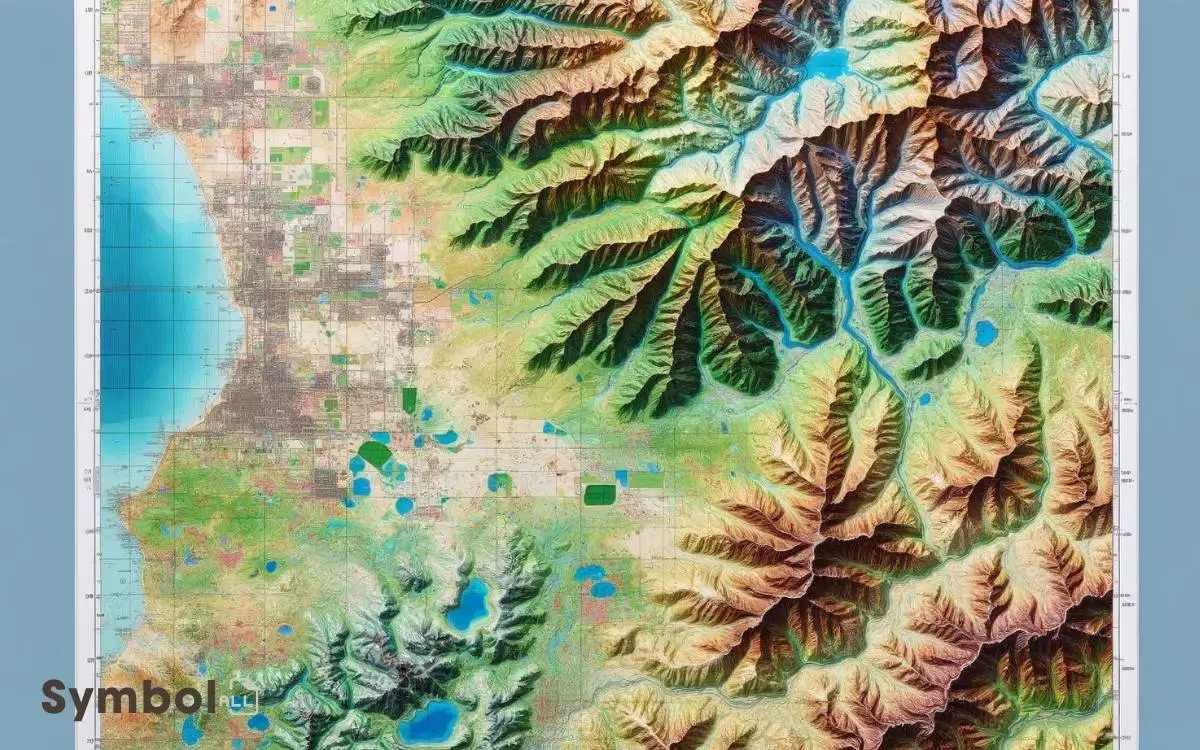Topographic Map Colors and Symbols: A Comprehensive Guide
In topographic maps, colors and symbols are key to revealing the landscape’s secrets.
- Greens indicate vegetation, with darker shades for dense forests and lighter for grasslands.
- Blues depict water bodies, their intensity mirroring depth or flow. Contour lines bring the terrain to life in three dimensions; their spacing reveals slope steepness, with tighter spacing for steep gradients.
- Browns portray elevation and relief, guiding you through the terrain’s contours.
- Red and black highlight roads and buildings, respectively, aiding in navigation.
Mastering these symbols and colors guarantees you’re well-equipped to interpret the map’s detailed narratives, opening pathways to deeper exploration.

Key Takeaway
Understanding Map Colors
To accurately navigate a topographic map, mastering the significance of its varied color palette is essential. Each hue is meticulously chosen to represent distinct terrain and landscape features.
Greens denote varying densities of vegetation, with darker shades indicating thicker, more impenetrable forests, and lighter ones suggesting open land or grassy areas.
Blues are reserved for water bodies, with the intensity reflecting the depth or flow rate of rivers, lakes, and oceans.
Browns depict elevations and landforms, but remember, we’re not delving into contour lines here. Whites often signify barren land or rock formations, devoid of significant vegetation.
Understanding these colors isn’t just about recognizing what’s on the ground; it’s about visualizing the terrain’s three-dimensional aspects from a bird’s-eye view. This visualization allows for strategic planning and navigation.
Decoding Contour Lines
To effectively navigate topographic maps, you’ll need to master contour lines, which represent the Earth’s surface in three dimensions.
Understanding these lines’ spacing reveals the terrain’s slope closer lines indicate steeper gradients, while wider spaces suggest vital slopes.
Grasping the concept of contour intervals is essential, as it determines the elevation change between each line, enabling precise readings of landscape features.
Understanding Contour Lines
Contour lines on a topographic map represent the elevation and shape of the terrain, with each line indicating a specific height above sea level. These lines are essential for understanding the topography of an area.
When you see lines that are close together, it indicates a steep slope. Conversely, lines that are spaced farther apart suggest a gentler slope.
Notice how contour lines form circles or loops; these shapes can reveal hills, valleys, and other features of the landscape.
For instance, closed loops are typically hills or mountains, with the smallest loops often representing the highest elevation.
Additionally, when a series of contour lines form a ‘V’ or a ‘U’ shape, they’re indicating a valley or a ridge, respectively, with the ‘V’ pointing towards higher elevation.
Contour Interval Significance
Understanding the contour interval, the vertical distance between adjacent contour lines, is crucial for accurately interpreting the terrain’s elevation changes and slope steepness.
This interval, often specified in the map’s legend, allows you to discern the terrain’s general configuration whether it’s a gentle slope, a steep incline, or a flat plateau.
By examining these intervals closely, you’re equipped to visualize the three-dimensional landscape on a two-dimensional map.
For instance, when contour lines are spaced closely together, it indicates a steep gradient, whereas lines that are spread apart suggest a gentler slope.
Importantly, the uniformity of these intervals ensures consistency in reading elevation changes across the map, providing a reliable tool for planning routes or understanding geographical features without the need for direct observation.
Reading Slope Gradient
By closely analyzing contour lines on a topographic map, you’ll uncover the slope’s gradient, revealing whether the terrain gently undulates or forms steep inclines. Understanding these gradients is vital for navigation and planning.
Contour lines that are closely spaced indicate a steep slope, whereas lines that are spread out suggest a gentle slope.
To precisely decode the slope gradient, consider these factors:
- Contour Interval: The vertical distance between adjacent contour lines. A smaller interval suggests a detailed map.
- Spacing Between Contour Lines: Directly correlates with the steepness of the terrain. Closer lines mean a steeper slope.
- Topographic Relief: The difference in elevation within a particular area, affecting overall gradient perception.
Gaining proficiency in reading these nuances enables accurate interpretation of terrain difficulty and landscape features.
Green: Vegetation and Forests
On topographic maps, you’ll notice varying shades of green, each denoting a specific type of vegetation or forest coverage. The darker the green, the denser the forest, allowing you to gauge forest density at a glance.
Additionally, specific symbols alongside these shades serve as vegetation density indicators, important for understanding the terrain’s vegetative characteristics.
Types of Green Shades
In topographic maps, varying shades of green denote different types and densities of vegetation and forest areas, providing essential information for understanding the natural landscape. These shades are meticulously chosen to represent specific vegetative features accurately.
Three key points regarding green shades on topographic maps include:
- Light Green often represents open, less dense vegetation areas, such as grasslands or shrublands.
- Medium Green is typically used for mixed vegetation areas that have a balance between trees and open land.
- Dark Green signifies dense, closed-canopy forests, but without detailing the specific density or type of forested area.
Understanding these shades is important for accurately interpreting the vegetated portions of the map, allowing for better planning and navigation through these natural landscapes.
Identifying Dense Forests
Having explored the general significance of green shades on topographic maps, let’s now focus on the specific cues that indicate dense forests within these vegetated areas. The distinction lies in the texture and pattern of green.
Dense forests are typically represented by darker shades of green, often accompanied by specific symbols or patterns that suggest a thick canopy cover.
To understand this better, consider the following table:
| Symbol | Emotion Evoked |
|---|---|
| Dark Green Fill | The depth of unexplored mysteries |
| Tree Icons | A sense of ancient, living history |
| Dense Dot Pattern | Intimacy with nature’s intricate details |
| Shaded Relief | The awe of nature’s undulating terrain |
| Textured Patterns | The complexity and richness of the wilderness |
Vegetation Density Indicators
Why is it important to recognize the varying shades of green on topographic maps? These shades aren’t just important; they serve as vital indicators of vegetation density, which can greatly impact your navigation and understanding of the terrain.
The density of vegetation can:
- Influence the difficulty of traversing an area.
- Affect visibility and the ability to use landmarks for navigation.
- Indicate the type of habitat and potential wildlife you might encounter.
Darker greens typically signify denser forests, while lighter greens might denote open grasslands or sparser vegetation. By interpreting these subtle differences, you’re equipped with knowledge about the landscape’s character, enabling more informed decisions whether you’re hiking, planning construction, or conducting environmental research.
Blue: Water Bodies Explained
Blue hues on topographic maps accurately represent water bodies, including rivers, lakes, and oceans, guiding you through aquatic features with precision.
The specific shades of blue and accompanying symbols provide detailed information about the nature of these water bodies.
| Symbol | Description | Example |
|---|---|---|
| Light Blue | Shallow water | Coastal areas |
| Dark Blue | Deep water | Deep lakes |
| Dotted | Intermittent water flow | Seasonal creeks |
For instance, a light blue area indicates shallower water, typically found in coastal zones or lake edges, whereas a darker blue signifies deeper water bodies, such as the center of large lakes or deep ocean areas.
Dotted lines or areas represent intermittent water flows, like creeks or streams that might not always hold water, depending on the season or current weather conditions.
Brown: Elevation and Relief
Brown shades on a topographic map meticulously delineate elevation changes and land relief, providing essential insight into the terrain’s contours and slopes.
As you analyze these maps, it’s important to understand that:
- Darker brown shades often signify steeper gradients and higher elevations.
- Lighter brown tones typically indicate more gradual slopes or lower elevations.
- Contour lines in close proximity suggest a sharp elevation change, illustrating ridges, valleys, or cliffs.
Red and Black: Roads and Buildings
As you examine a topographic map, you’ll notice roads depicted in various shades of red and black, each hue and pattern specifying a different type of roadway, from highways to minor roads.
Black symbols and outlines often represent buildings, with distinct shapes indicating the structure’s purpose, such as residential, commercial, or industrial.
Understanding these colors and symbols allows you to navigate and interpret the map’s detailed landscape with precision.
Road Types Explained
In topographic maps, red and black lines and symbols distinctly represent various road types and buildings, providing essential guidance information. When you’re exploring, understanding the distinctions between road types is vital.
Here’s a breakdown:
- Major Highways: Usually depicted in red, these are wide, easily noticeable lines that signify primary roads designed for fast, long-distance travel.
- Secondary Roads: Often shown in a lighter shade of red or black, these roads connect smaller towns and are less prominent than major highways.
- Unpaved Tracks: Typically represented by dashed or dotted black lines, indicating routes that might be challenging for standard vehicles.
Each type of road has its unique symbol or line style, enabling precise orientation. Recognizing these differences helps you plan routes more effectively and understand the terrain you’ll encounter.
Identifying Buildings Easily
Shifting from road types, understanding how topographic maps utilize red and black symbols to depict buildings is crucial for easy recognition amidst diverse landscapes.
These symbols, carefully crafted, function as a visual shorthand for structures ranging from residential houses to significant industrial complexes.
Typically, black outlines represent the footprint of buildings, providing a sharp contrast against the map’s background, thereby aiding quick identification.
Red, on the other hand, is reserved for more prominent or crucial structures, establishing a hierarchy of visual importance on the map.
Additionally, you’ll observe that the use of shading and texture within these symbols can convey additional details, such as the building’s height and material. Additionally, these visual elements can help identify key characteristics of the structures, such as distinguishing between residential and commercial buildings. When combined with different annotations or labels, they provide a more comprehensive understanding of the environment. For a deeper insight into how infrastructure is categorized, having utility marking colors explained alongside these symbols enhances clarity and ensures accurate interpretation.
Mastering the interpretation of these symbols enables you to navigate and comprehend the built environment illustrated in topographic maps accurately and effortlessly.
White: Non-Vegetated Areas
On topographic maps, white areas pinpoint locations devoid of significant vegetation, indicating bare rock, sand, or snow-covered landscapes.
These regions are vital for understanding the geographical and environmental makeup of an area.
When analyzing these maps, it’s crucial to interpret the white spaces accurately to grasp the terrain’s characteristics fully.
To underscore, consider the following:
- Bare Rock: Indicates exposed bedrock without soil cover, often found in mountainous or arid regions.
- Sand: Typically represents deserts, beaches, or dunes, areas where soil is primarily sandy and vegetation is sparse or non-existent.
- Snow-covered Landscapes: Signifies regions under snow, important for evaluating seasonal changes or glacial activity.
Understanding these nuances allows for a more precise navigation and interpretation of the terrain, aiding in planning and decision-making processes.
Purple: Revisions and Changes
While exploring topographic maps, you’ll notice that areas marked in purple denote revisions or updates to the terrain or man-made features that have occurred since the map’s last publication.
This color is important for understanding the most recent changes that aren’t reflected in the map’s primary edition.
Purple markings can range from minor alterations in topography to significant construction developments.
This color coding is vital for navigators, planners, and researchers who rely on the most current geographical information. It guarantees that users are aware of changes that might affect navigation or land use planning.
Yellow: Open Land and Desert
Yellow areas on topographic maps signify open land or desert terrain, offering important data for understanding the landscape’s natural features.
These zones are pivotal for navigators, hikers, and geologists, providing insights into the area’s vegetation, or lack thereof, and the potential challenges one might face when traversing these regions.
Here are three key points about yellow-coded areas:
- Vegetation Sparse: Indicates regions where vegetation is minimal, aiding in identifying arid or semi-arid zones.
- Surface Texture: Highlights the texture of the ground, which might range from sandy to rocky, essential for determining the ease of travel.
- Temperature Considerations: Suggests areas that might experience extreme temperatures, essential for planning purposes regarding hydration and protective clothing.
Understanding these nuances aids in preparing effectively for expeditions into these expansive terrains.
Symbols and Their Meanings
Moving beyond the color-coded regions, it’s vital to decode the myriad symbols scattered across topographic maps, each offering precise insights into the landscape’s physical features and human-made structures.
For instance, small rectangles often indicate buildings, while lines with alternating dashes and dots symbolize minor roads or trails.
Water bodies are represented by blue lines or shapes, with the flow direction occasionally marked by arrows.
Contour lines, those thin, concentric circles, reveal the terrain’s elevation changes, getting closer together as the slope becomes steeper.
Understanding these symbols is paramount, as they give you a detailed, nuanced understanding of the area you’re examining.
Recognizing each symbol’s meaning enhances your ability to interpret the map’s information accurately, essential for navigation and planning in any outdoor or professional activity.
Navigating With Scale and Orientation
Having mastered the symbols and colors on topographic maps, you’ll now find that understanding scale and orientation is crucial to accurately traversing any terrain.
Scale, represented as a ratio, informs you of the distance on the ground that a specific length on the map covers.
Orientation, typically aligned with magnetic north, requires you to adjust your compass accordingly.
To navigate effectively, consider these elements:
- Scale Interpretation: Grasp the map’s scale to gauge real-world distances. A 1:50,000 scale means 1 unit on the map equals 50,000 units in reality.
- True North vs. Magnetic North: Understand the difference and how it impacts compass use.
- Map Alignment: Regularly align your map with the surrounding landscape and your compass to maintain orientation.
Mastering these skills ensures precise navigation and enhances your outdoor experiences.
Practical Tips for Map Reading
To effectively utilize a topographic map in the field, you’ll need to master several practical tips that go beyond just understanding its symbols and scales.
Initially, always confirm your map is oriented with the landscape. Rotate it so features align with what you’re seeing; this might involve using a compass.
Next, identify major landmarks that can serve as reference points; these can be peaks, rivers, or built structures.
Thirdly, pay close attention to contour lines—closely spaced lines indicate steep terrain, while wider gaps suggest a gentler slope. Use this information to plan your route, avoiding unnecessary elevation gain.
Conclusion
Traversing the world’s canvas requires more than just eyes; it demands an ability to decipher its encoded brush strokes.
The colors and symbols on a topographic map aren’t mere embellishments; they’re the language of the Earth, whispering its secrets.
Embrace the greens of life, the blues of sustenance, the browns of foundation, and the yellows of openness.
Each contour, symbol, and scale is a key to revealing the mysteries hidden in plain sight. Master this language, and the world unfolds beneath your feet.






